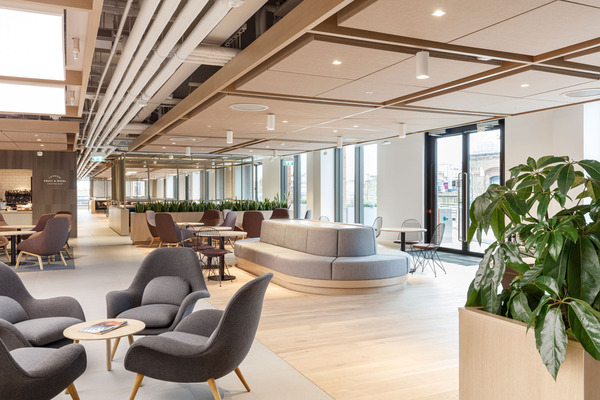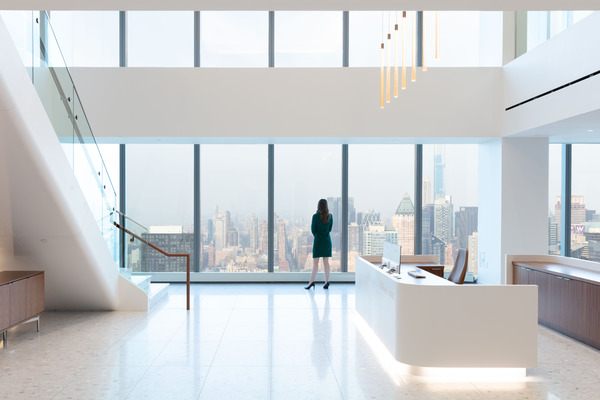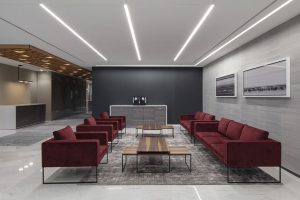Rewriting the Law Office Playbook: Lessons from the Field
Even before the COVID-19 pandemic, workplace planning for the legal sector was in the midst of change. Open-plan floor plates, hoteling options, “huddle” rooms, enhanced technologies—these elements had already begun making their way into the new law office environment.
But now that the future of the workplace is still in flux, how do firms best position their workplace for change? Developing an office design and construction “playbook” that captures lessons learned, provides guidance on a tailored procurement strategy, and helps provide more predictable outcomes can help law firms—particularly those with a global footprint—better plan, design, and build offices that accommodate flexibility, support inclusion, diversity, and employee wellness, and foster productivity.
Paving the Way for Change
Long before COVID, law firms were exploring new ways of working, including the benefits of a flexible, more open office space. As study after study proved the benefits of an open office to collaboration, culture, and efficiency—not to mention cost—several firms began making the shift.

Milbank LLPGo to https://stobuildinggroup.com/projects/milbank-llp/, for instance, hoped their new space in New York City’s Hudson Yards would help foster the firm’s collaborative and community feel by reducing the size of private offices, adding amenity and conference floors, and connecting all ten floors with a central staircase. Milbank chairman, Scott Edelman, said the new space is a marked contrast from the heavy wooden walls of their former space and a more attractive look and feel for junior staff.
“We are really focused on attracting the very best talent at the associate ranks,” Edelman said, adding the office’s features are directed to make sure “the associate experience is as positive as we can make it, so that we can get and keep the very best people.”
Located in the same high-rise, Boies Schiller Flexner wanted their new space to reflect the way their staff was already working—and the data-driven approach of their design partner, Schiller Projects, helped them build a completely custom space.
“In BSF’s previous space, you could go in, get on a conference call with a lawyer who might only be two rooms down and never see the person all day,” says Aaron Schiller, principal at Schiller Projects. “BSF wanted to blow that up, not because they were fundamentally changing the way they practiced, but because they were aware that the space they were in did not support the way that they had been practicing.”
The COVID Catalyst
This workplace shift over the last several years has, in some ways, prepared the legal sector for the changes that have come with the pandemic. As far back as 2017, a Cushman & Wakefield survey of law firm clients reported that 62% of respondents would work remotely more often in 5 years. That number rose to 78% in early 2020 and jumped to 96% in Q2 2020. The shift was already happening, and the virtual workplace forced by COVID has made this flexible model all the more feasible.
But, says Marty Festenstein, principal and Legal Workplace practice chair at NELSON, not all firms—or attorneys—are cut from the same cloth. While some level of virtual work may continue to be attractive to some firms, the ability to maintain confidentiality is a must across the board.
“We will see some elements of a hybrid approach continue, like shared offices, universal-size offices, or interior offices for attorneys,” he says. “But if someone needs an office for the day, the firm will need to support that, with integrated workplace management system technology on handheld devices, access to files, quiet space to work, and tech integration that’s ubiquitous. These are the features that will prevail as alternative concepts to occupancy are being struck.”
With so much uncertainty on the best steps forward, the relationships formed before the pandemic are proving crucial, particularly for global, multi-office practices who have worked with project teams on multiple offices.
“Attorneys are historically slow to adopt change—they wait until they understand what their peer firms are doing,” says Festenstein. “The value of engaging your architect and contractor partners early in the project planning process comes in the real-time information and experiences they can share about why a certain approach, for example, might provide a 20% premium over another.”
For example, because firms often make real estate choices at the local level, one office may have 30 different types of light bulbs and ballasts and another office may have another set—which means 30 different types of light bulb and ballast issues in each office. “That’s not something the firm will want to have to keep track of over the life of each lease,” says Eugene P. White, executive vice president of client relations at STO Building Group. “As a construction partner, we think about how we can help streamline those decisions across a firm’s portfolio and provide uniformity so they can avoid that burden.”
Project Partners
The key factor that differentiates law firm office projects from those of other corporate clients is the structure of ownership. As partners in the firm, these clients are literally personally invested in the success and outcomes of creating a new workplace. That’s where bringing in those relationships as early as possible makes all the difference.
“Historically, law firms have perceived the construction manager or general contractor bid process as a way to ensure their dollar goes further,” says White. “But recently, many firms have begun to realize what most of corporate America has known for years—that early due diligence and partnership with the construction team, even as early as the pre-lease stage, can save significant dollars and set the stage for a smooth project.”
With this unified strategic approach, the CM can contribute to capital expenditure budgets and assess short-listed sites. In addition, the CM and team can develop a strategic procurement plan—an element often overlooked by law firms. “Many law firms don’t think they have the volume to leverage their spend like a large corporation might. But that’s not the case,” says White. “Many material suppliers are keen to develop relationships directly with the construction managers on behalf of global law firms. Not only does this help lower costs, but it helps better control the supply chain.”
And cost control is, of course, a key focus for most firms.
“People in charge of capital projects for a law firm are expected to manage the partners’ investments thoughtfully and carefully,” says Festenstein. “As a result, they need an understanding of where the costs are to achieve the project’s goal. That’s why the partnership between the client, architect, and GC is such a critical component.”
The Playbook Approach
Over the last 20 years of working with Am Law 100 firms in cities across the US, Canada, and Europe, STO Building Group has learned to develop a “playbook” of sorts for each client. In other words, they compile a central resource for all the lessons learned, preferences, culture notes, and the like about their law firm clients. The company shares that playbook with the client so they too have access to the intelligence gathered from their projects to inform how they develop strategies, get the most value for the partnership, and have more predictable outcomes.
As an example, during a project for a top Am Law client, the STO Building Group project team discovered that the firm’s internal IT and AV teams were brought into the white noise design process late in the game. As a result, the sheetrock band in front of all the offices had to be cut open and the ceiling tiles shifted to accommodate the system. Engaging that internal team early could have avoided some of that back and forth during construction, a lesson they recorded in the client’s playbook and were able to apply to an office renovation in another location.
Other factors the STO Building Group typically includes in their playbooks:
• Results from pre-lease building evaluations and lease reviews
• Benchmarking/capital expenditure budgeting
• Procurement savings and strategy
• Support for diversity and inclusion goals
• Support for sustainability goals (LEED & WELL Certification)
• Architectural detail reviews for impact on long-term maintenance
• Communication and reporting protocols
• KPIs to measure success project to project
• Notes on any value added throughout the project
Because the STO Building Group is geographically diverse, their local experts are able to combine an understanding of local market factors with the perspectives of working in other market as well and capture that data in a client playbook. For example, STOBG documents the furniture, AV, and other vendors for a project as well as their communications history and relationships with them. That established relationship makes it that much easier to kick off a new project together from the same vantage point.
Material costs since the pandemic are another example of where the local vs. global perspective is a benefit. “Costs for certain materials were surging before COVID. Once the pandemic hit, some costs went down, some went drastically up, and some have come back down,” says White. “Our supply chain experts have been tracking these fluctuations and trends and regularly share updates with our team to provide guidance on what impact that may have on the schedule and costs of our projects.”
Strategy for the Win
Coming at these projects strategically, as a team, with a shared history and understanding positions a firm to not only create a workplace that meets its current needs, but also develop their own playbook and game plan for adjusting to changes that may come over the life of the office. And in the current climate of unknowns and continual change, the constant of a strong, strategic partnership can make all the difference.
“We must all look at what we can do to understand the accommodation of unforeseen change,” says Festenstein. “That means putting in infrastructure that allows for minimal capital investment over the lease term in order to make change without serious cost. Who would know better than the combined architect and construction management team? It just makes sense.”
The STO Building Group family of companies has been working with Am Law’s top global law firms for decades. Through these relationships and the benefit of experience on law firm projects of all sizes in nearly every major market, we have built a thorough understanding of what the modern law firm looks for in a workplace. From building a new headquarters to advising on small upgrades, we have the resources, expertise, and relationships to help our clients realize their vision for a modern, sustainable, and high-quality workplace—anywhere in the world.

AshurstGo to https://stobuildinggroup.com/projects/ashurst-london-fruit-and-wool-exchange/, London, UK



